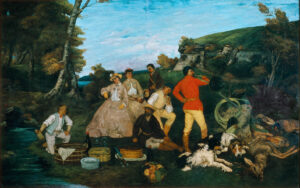While hunting, his favorite sport, Brillat-Savarin enjoyed the haltes de chasse or midday luncheon. Brillat-Savarin knew first-hand the pleasures of dining in the field and expected all food and wines to be carried or delivered to a place designated explicitly. “Salon dining is wonderful and elegant,” he writes, but the halte de chasse “provides vivacity that no salon dining room can match.” The joy of this alfresco gathering, Brillat-Savarin contends, is an émanation du ciel (emanation of heaven) that gives the meal une vivacité inconnue dans les enclos (closed rooms), however well decorated.
In “Meditation XV” of Physiologie du Gout or The Psychology of Taste, Brillat-Savarin follows French usage and does not refer to the halte de chasse as a pique-nique. English translators observe this: Fayette Robinson prefers the literal “halte de chasse,” Anne Drayton uses “pause in the chase” or “shooting-luncheon,” and M.F.K. Fisher makes it a “hunting luncheon.”
Brillat-Savarin’s luncheon during the hunt is observed in two ways: one is informal, and the other is sophisticated and festive. Of the former, when hunters a trysting place, they pause and snack while waiting for their wives, lovers, and friends to arrive. “Shade attracts him; the turf receives him; the murmur of the rivulet advises him to open the flask he has brought to revive himself with. Thus placed, he takes out the little well-baked loaves, uncovers the cold chicken some kind hand has placed in his haversack, and finds the piece of Gruyere or Roquefort, which is to represent a dessert.” In a footnote, Brillat–Savarin says that he prefers white wine because it “resists heat better than any other.”

Gustave Courbet. Halte de Chasse (1858)
The halte de chasse’s festive portion begins when the caléches, the hunters’ women, and other friends arrive. As the crowd mingles, staff spreads pâtés de Perigord, the wonders of Strasbourg [charcuterie], the delicacies of d’Achard [patisseries from Chez Achard], and all that the best laboratories [kitchens] produce that is transportable. Instead of the tepid wine carried in backpacks, staff provides “foaming champagne, and “Corks fly,” he assures readers, “all laugh, jest, and are happy.”
Not to be deterred too long, the men pick up their guns, and the ladies put on their hats. There are many goodbyes, but the hunt must resume.
*Among hunters, a tryst is a designated meeting place. The halte de chasse or repas de chasse is a popular theme among painters such as Watteau, Lancret, and that ilk. But the Courbet’s Le Repas de Chasse (1858) seems closest in style to Brillat-Savarin’s.
Featured Image: A lithograph by Alphonse Farcy for Physiology of Taste by Brillat-Savarin (1867). http://gallica.bnf.fr/ark:/12148/btv1b9012870m/f1.item
See Jean-Anthelme Brillat-Savarin’s The Physiology of Taste or Meditations on Transcendental Gastronomy. Paris: Chez A. Sautelet et Cie, 1826; The Physiology of Taste, or Meditations on Transcendental Gastronomy. Edited and Translated by Fayette Robinson. Philadelphia: Lindsay and Blakiston, 1854; The Physiology of Taste, or Meditations on Transcendental Gastronomy. Edited and Translated by M.F.K. Fisher. New York: Harcourt Brace Jovanovich, 1978; The Physiology of Taste, or Meditations on Transcendental Gastronomy (1825). Edited and Translated by Anne Drayton. New York: Penguin, 1978

